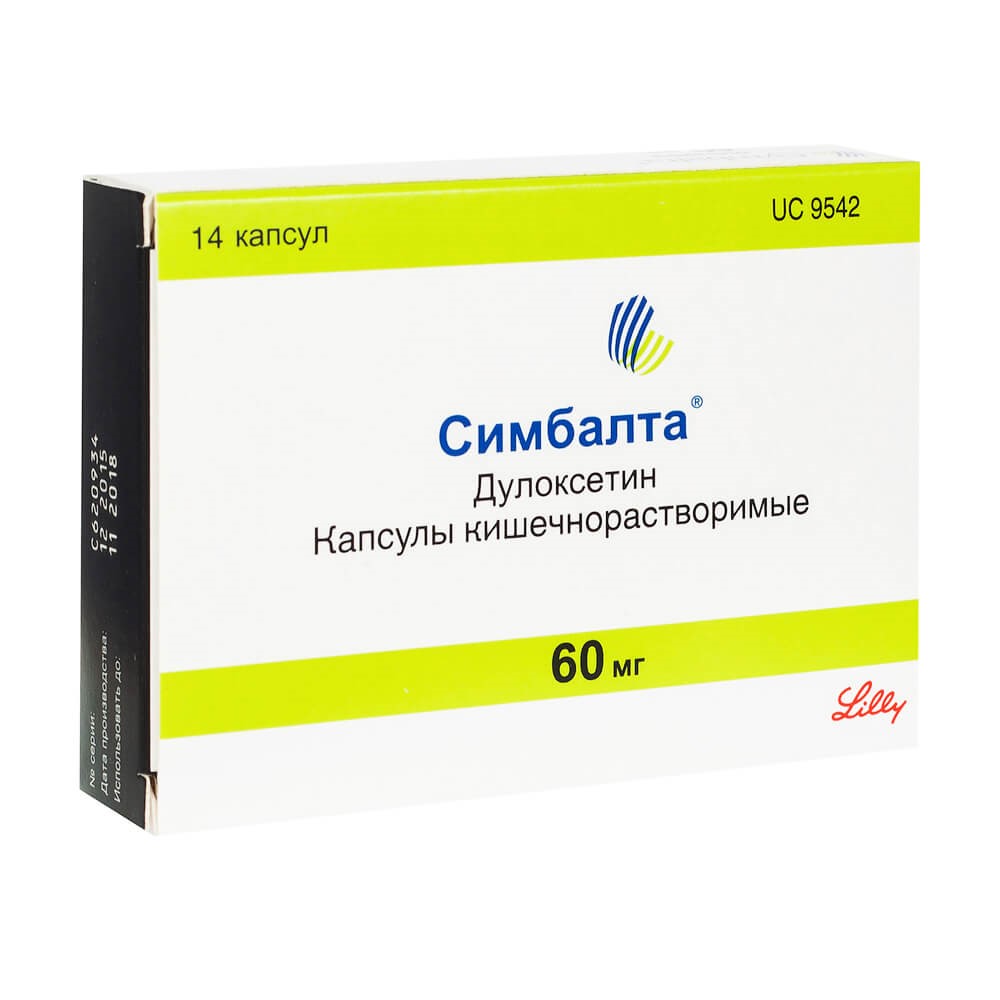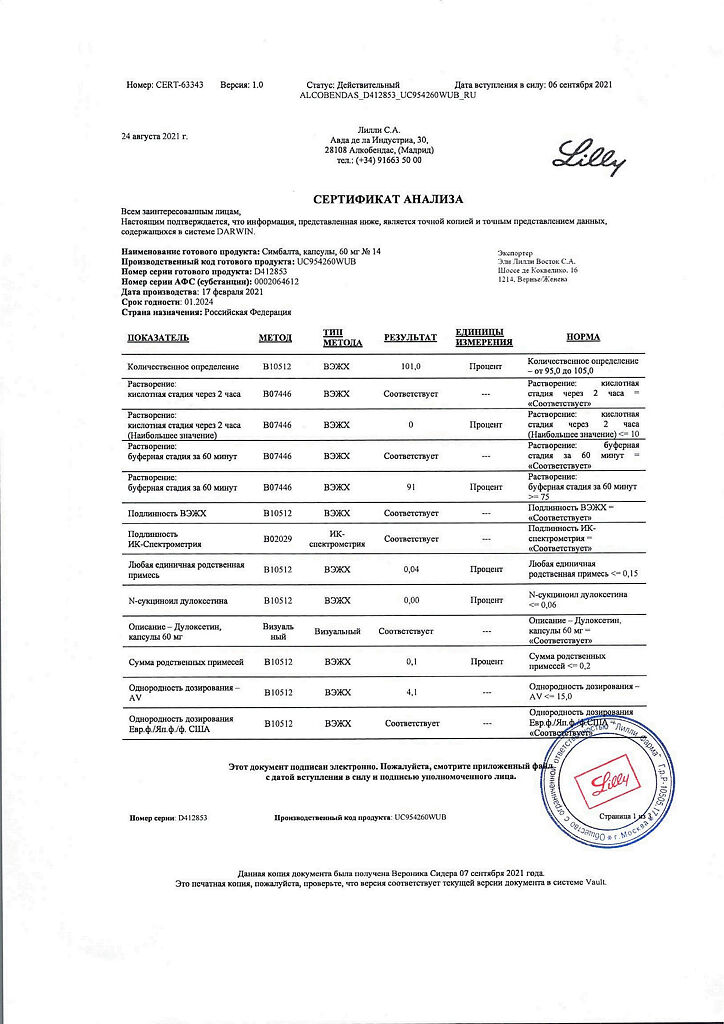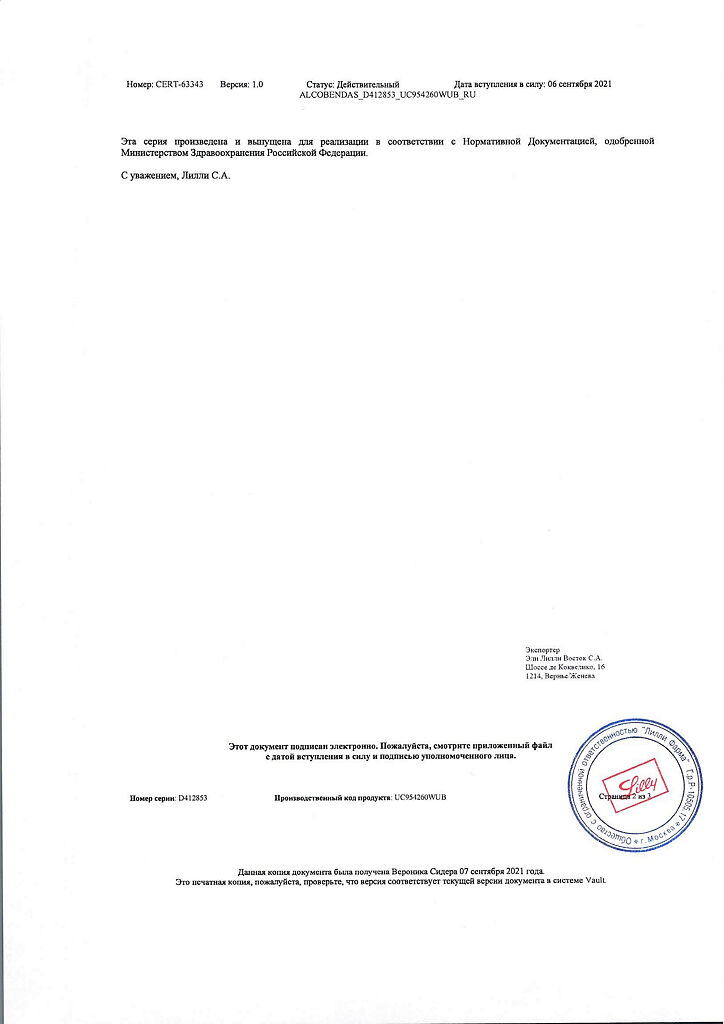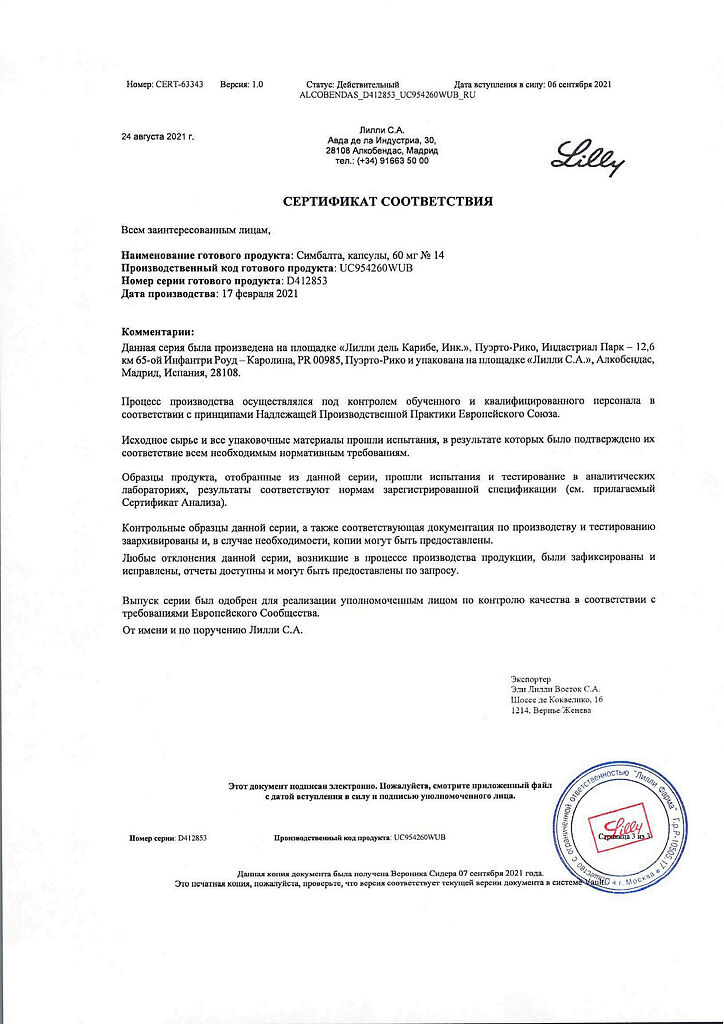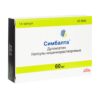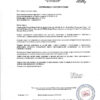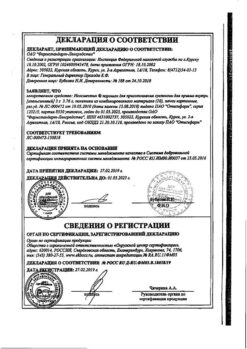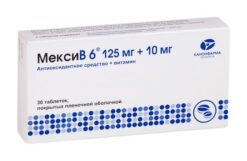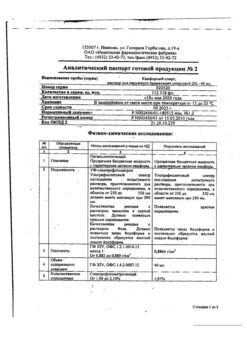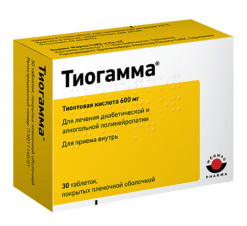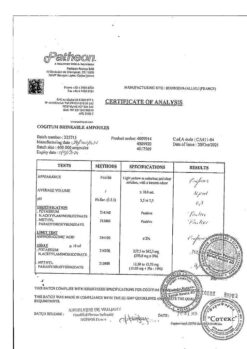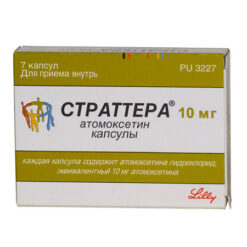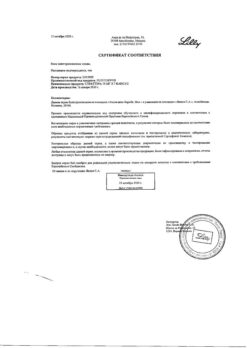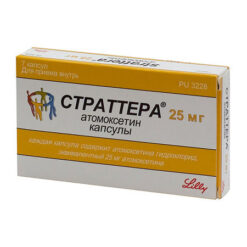No products in the cart.
Cymbalta, 60 mg capsules 14 pcs
€67.02 €55.85
Description
Symbalta has an antidepressant effect.
Pharmacodynamics
Duloxetine is an antidepressant, serotonin and norepinephrine reuptake inhibitor and weakly inhibits dopamine reuptake, with no significant affinity for histaminergic, dopaminergic, cholinergic and adrenergic receptors. The mechanism of action of duloxetine in the treatment of depression is to inhibit serotonin and norepinephrine reuptake, resulting in increased serotonergic and noradrenergic neurotransmission in the CNS.
Duloxetine has a central mechanism of pain syndrome suppression, which is primarily manifested by an increase in the threshold of pain sensitivity in pain syndrome of neuropathic etiology.
Pharmacokinetics
Intake. Duloxetine is well absorbed when taken orally. Absorption begins 2 h after taking the drug. Cmax is reached 6 h after ingestion.
Eating does not affect the maximum concentration of the drug, but increases the time to reach Cmax from 6 to 10 hours, which indirectly reduces the degree of absorption (approximately 11%).
Distribution. Duloxetine binds well to plasma proteins (>90%), mainly to albumin and α1-globulin; hepatic or renal disorders have no effect on degree of protein binding.
Metabolism. Duloxetine is actively metabolized, and its metabolites are mainly excreted in the urine.
The CYP2D6 and CYP1A2 both catalyze the formation of two major metabolites (4-hydroxyduloxetine glucurone conjugate, 5-hydroxy-6-methoxyduloxetine sulfate conjugate).
Circulating metabolites have no pharmacological activity.
Evacuation. The duration of T1/2 of duloxetine is 12 h. Average Cl of duloxetine is 101 l/h.
Separate patient groups
Gender: Although differences in pharmacokinetics have been found in men and women (mean clearance of duloxetine is lower in women), these differences are not so great as to necessitate a dose adjustment based on gender.
Age: Although differences in pharmacokinetics have been found in middle-aged and elderly patients (AUC is higher and duration of T1/2 of the drug is longer in the elderly), these differences are not sufficient to change the dose based on patient age alone.
Kidney function impairment: In patients with severe renal impairment (terminal chronic renal failure) on hemodialysis, the Cmax and AUC values of duloxetine were increased 2-fold. Therefore, consideration should be given to reducing the dose of the drug in patients with clinically significant impaired renal function.
Hepatic impairment: In patients with clinical signs of hepatic impairment there may be delayed metabolism and excretion of duloxetine. After a single dose of 20 mg duloxetine, 6 patients with cirrhosis and moderate hepatic impairment (Child-Pugh class B) had a T1/2 duration of duloxetine approximately 15% longer than that of healthy subjects of the corresponding sex and age with a fivefold increase in mean AUC exposure. Although the Cmax in cirrhotic patients was the same as in healthy subjects, the T1/2 was about 3 times longer.
Indications
Indications
Depression; a painful form of diabetic neuropathy.
Pharmacological effect
Pharmacological effect
Cymbalta has an antidepressant effect.
Pharmacodynamics
Duloxetine is an antidepressant, a serotonin and norepinephrine reuptake inhibitor and weakly inhibits dopamine uptake, without having significant affinity for histaminergic, dopaminergic, cholinergic and adrenergic receptors. The mechanism of action of duloxetine in the treatment of depression is to inhibit the reuptake of serotonin and norepinephrine, resulting in increased serotonergic and noradrenergic neurotransmission in the central nervous system.
Duloxetine has a central mechanism for suppressing pain, which is primarily manifested by an increase in the threshold of pain sensitivity in pain of neuropathic etiology.
Pharmacokinetics
Suction. Duloxetine is well absorbed when taken orally. Absorption begins 2 hours after taking the drug. Cmax is reached 6 hours after administration.
Eating does not affect the maximum concentration of the drug, but increases the time to reach Cmax from 6 to 10 hours, which indirectly reduces the degree of absorption (by approximately 11%).
Distribution. Duloxetine binds well to plasma proteins (>90%), mainly to albumin and α1-globulin; liver or kidney disorders do not affect the degree of protein binding.
Metabolism. Duloxetine is extensively metabolized, and its metabolites are mainly excreted in the urine.
Both CYP2D6 and CYP1A2 catalyze the formation of two main metabolites (4-hydroxyduloxetine glucuronic conjugate, 5-hydroxy-6-methoxyduloxetine sulfate conjugate).
Circulating metabolites do not have pharmacological activity.
Excretion. The duration of T1/2 of duloxetine is 12 hours. The average Cl of duloxetine is 101 l/hour.
Selected patient groups
Gender: Although differences in pharmacokinetics have been identified between men and women (the average clearance of duloxetine is lower in women), these differences are not so great as to require dose adjustment based on gender.
Age: Although differences in pharmacokinetics have been identified in middle-aged and elderly patients (AUC is higher and the duration of T1/2 of the drug is longer in the elderly), these differences are not sufficient to change the dose depending only on the age of the patients.
Impaired renal function: in patients with severely impaired renal function (end-stage chronic renal failure) undergoing hemodialysis, the Cmax and AUC values of duloxetine increased 2-fold. In this regard, the advisability of reducing the dose of the drug in patients with clinically significant renal impairment should be considered.
Liver dysfunction: Patients with clinical signs of liver failure may experience a decrease in the metabolism and elimination of duloxetine. Following a single dose of 20 mg duloxetine in 6 patients with cirrhosis and moderate hepatic impairment (Child-Pugh class B), the T1/2 duration of duloxetine was approximately 15% higher than in sex- and age-matched healthy controls, with a fivefold increase in mean AUC exposure. Despite the fact that Cmax in patients with cirrhosis was the same as in healthy people, T1/2 was approximately 3 times longer.
Special instructions
Special instructions
MAO inhibitors. In patients receiving a serotonin reuptake inhibitor in combination with MAO inhibitors, cases of serious reactions, sometimes fatal, have been reported, including hyperthermia, rigidity, myoclonus, peripheral disturbances with possible sharp fluctuations in vital signs, and changes in mental status, including severe agitation leading to delirium and coma.
These reactions have also been observed in patients in whom a serotonin reuptake inhibitor was discontinued shortly before initiation of MAO inhibitors. In some cases, patients experienced symptoms consistent with neuroleptic malignant syndrome. The effects of combined use of duloxetine and MAO inhibitors have not been evaluated in either humans or animals. Therefore, given the fact that duloxetine is a reuptake inhibitor of both serotonin and norepinephrine, it is not recommended to take duloxetine in combination with MAO inhibitors or for at least 14 days after stopping treatment with MAO inhibitors. Based on the half-life of duloxetine, a break of at least 5 days should be taken after stopping duloxetine before taking MAO inhibitors.
Exacerbation of manic/hypomanic states: As with similar drugs that act on the central nervous system, duloxetine should be used with caution in patients with a history of manic episodes.
Epileptic seizures: As with similar drugs that affect the central nervous system, duloxetine should be used with caution in patients with a history of epileptic seizures.
Mydriasis: Cases of mydriasis have been observed with duloxetine, so caution should be exercised when prescribing duloxetine to patients with elevated intraocular pressure or risk of developing acute angle-closure glaucoma.
Hepatic or renal impairment: in patients with severe renal impairment (Cl creatinine
Suicidal attempts: with depression, there is a possibility of suicide attempts, which may persist until stable remission occurs. Careful monitoring of patients at risk is necessary.
Driving a car and performing work that requires increased attention
During studies of duloxetine, no impairment of psychomotor reactions, cognitive functions and memory was identified. However, taking the drug may be accompanied by drowsiness. In this regard, patients taking duloxetine should exercise caution when operating mechanical devices, incl. by car.
Active ingredient
Active ingredient
Duloxetine
Composition
Composition
1 capsule contains:
active ingredient:
duloxetine (as hydrochloride) 60 mg
excipients:
sucrose;
hypromellose;
granulated sugar (no more than 91.5% sucrose, starch);
talc;
hypromellose acetate succinate;
triethyl citrate;
white dye (titanium dioxide, hypromellose)
capsule shell:
indigo carmine; titanium dioxide; sodium lauryl sulfate; gelatin; iron oxide yellow dye (only for 60 mg capsules)
Pregnancy
Pregnancy
Due to insufficient experience with the use of Cymbalta during pregnancy, the drug should be prescribed during pregnancy only if the potential benefit to the patient significantly outweighs the potential risk to the fetus. Patients should be warned that if they become pregnant or plan to become pregnant during treatment with duloxetine, they should inform their doctor.
Due to the lack of experience with the use of duloxetine in women during breastfeeding, breastfeeding is not recommended during duloxetine therapy.
Contraindications
Contraindications
hypersensitivity to Cymbalta;
simultaneous use with MAO inhibitors;
uncompensated angle-closure glaucoma.
With caution:
exacerbation of manic/hypomanic state;
epileptic seizures;
mydriasis;
impaired liver or kidney function;
the likelihood of suicide attempts.
Side Effects
Side Effects
The most common (10%) observed in clinical studies were: dizziness (except vertigo), dry mouth, nausea, constipation, sleep disturbance (drowsiness or insomnia) and headache. Headache was reported less frequently than with placebo.
Less often (from 1 to
Dizziness, nausea, and headache were reported as common adverse effects when discontinuing duloxetine.
A slight increase in fasting blood glucose may occur when taking duloxetine in patients with painful diabetic neuropathy.
Interaction
Interaction
Drugs metabolized by CYP1A2. Concomitant use of duloxetine (60 mg 2 times daily) did not have a significant effect on the pharmacokinetics of theophylline, which is metabolized by CYP1A2. Duloxetine is unlikely to have a clinically significant effect on the metabolism of CYP1A2 substrates.
CYP1A2 inhibitors. Because CYP1A2 is involved in the metabolism of duloxetine, concomitant use of duloxetine with potential CYP1A2 inhibitors is likely to result in increased duloxetine concentrations. A potent CYP1A2 inhibitor, fluvoxamine (100 mg once daily), reduced the mean plasma clearance of duloxetine by approximately 77%. Caution should be exercised when prescribing duloxetine with CYP1A2 inhibitors (for example, some quinolone antibacterial agents) and use lower doses of duloxetine.
Drugs metabolized by CYP2D6. Duloxetine is a moderate CYP2D6 inhibitor. When taking duloxetine at a dose of 60 mg 2 times a day with a single dose of desipramine, a CYP2D6 substrate, the AUC of desipramine increases 3-fold. Co-administration of duloxetine (40 mg twice daily) increased the steady-state portion of the AUC of tolterodine (2 mg twice daily) by 71% but had no effect on the pharmacokinetics of the 5-hydroxyl metabolite. Therefore, caution should be exercised when using duloxetine with drugs that are primarily metabolized by the CYP2D6 system and have a low therapeutic index.
CYP2D6 inhibitors. Since CYP2D6 is involved in the metabolism of duloxetine, concomitant use of duloxetine with potential CYP2D6 inhibitors may result in increased duloxetine concentrations.
Paroxetine (20 mg once daily) reduced the mean clearance of duloxetine by approximately 37%. Caution should be exercised when using duloxetine with CYP2D6 inhibitors (eg SSRIs).
Drugs affecting the central nervous system. Caution should be exercised when using duloxetine in combination with other drugs and agents that affect the central nervous system, including alcohol, especially those that have a similar mechanism of action.
Drugs that are highly bound to blood proteins. Duloxetine is highly bound to plasma proteins (>90%). Therefore, the administration of duloxetine to a patient who is taking another drug that is highly bound to plasma proteins may lead to increased concentrations of the free fractions of both drugs.
Overdose
Overdose
Several cases of overdose have been reported with simultaneous oral administration of up to 1400 mg of the drug, which did not have fatal consequences. Overdose may be accompanied by the following symptoms: tremor, clonic convulsions, ataxia, vomiting and loss of appetite.
Treatment: no specific antidote is known. Cardiac monitoring and vital signs are recommended along with symptomatic and supportive treatment.
Storage conditions
Storage conditions
At 15–30 °C
Shelf life
Shelf life
2 years
Manufacturer
Manufacturer
Lilly del Caribe Inc., Puerto Rico
Additional information
| Shelf life | 2 years |
|---|---|
| Conditions of storage | At 15-30 °C |
| Manufacturer | Lilly del Caribe Inc., Puerto Rico |
| Medication form | capsules |
| Brand | Lilly del Caribe Inc. |
Related products
Buy Cymbalta, 60 mg capsules 14 pcs with delivery to USA, UK, Europe and over 120 other countries.

